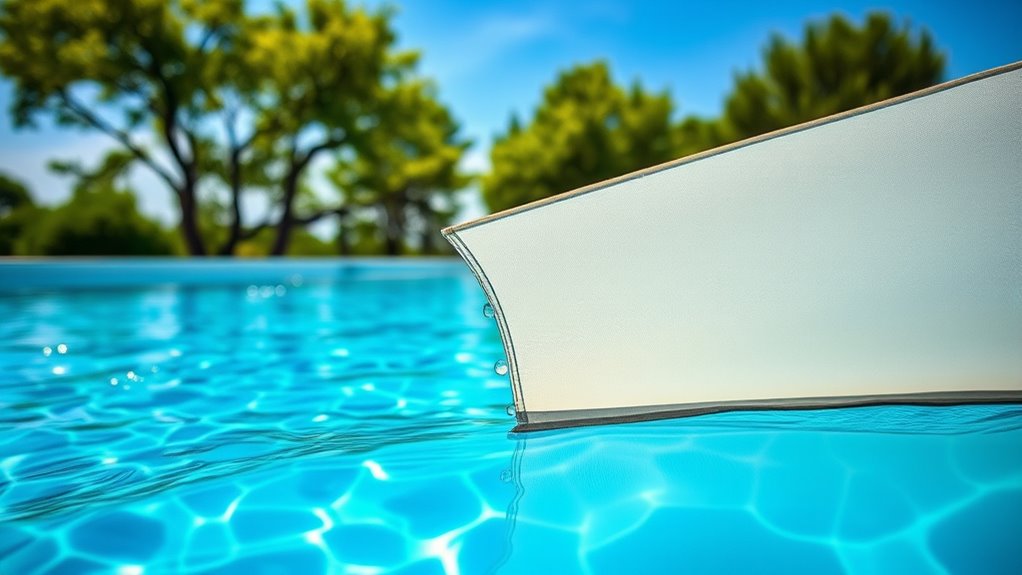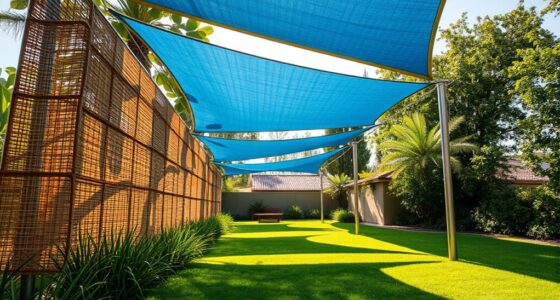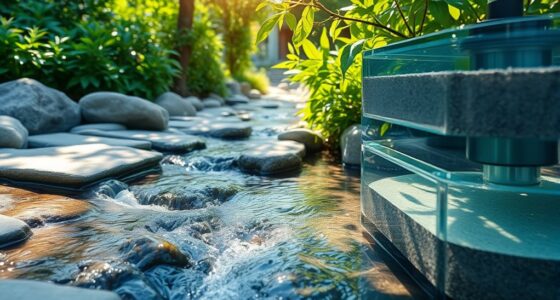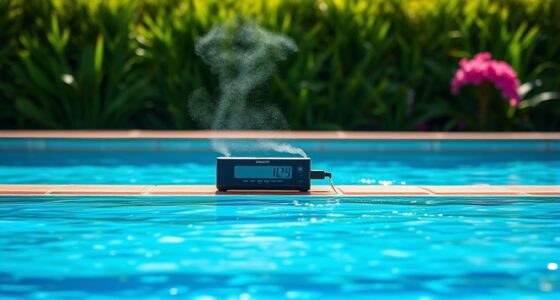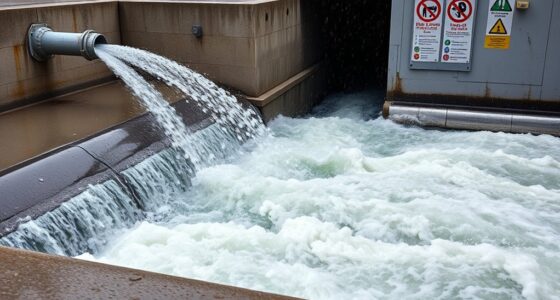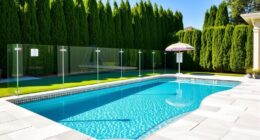To save water and keep your pool full, cover it with a pool blanket or solar cover when not in use to prevent evaporation. Add wind barriers like fences or plants to block airflow, and adjust your water levels regularly to avoid unnecessary loss. Schedule swimming during cooler, less windy times, and use evaporation-resistant surface treatments to reduce water loss. Want to learn more effective strategies? Keep exploring for simple, proven tips that really make a difference.
Key Takeaways
- Cover your pool with a solar or bubble cover to prevent evaporation when not in use.
- Install wind barriers like fences or dense shrubbery to reduce airflow and moisture loss.
- Schedule swimming during cooler, less windy times such as early mornings or evenings.
- Apply evaporation-resistant surface treatments and maintain proper water chemistry to minimize water loss.
- Regularly monitor and adjust water levels to prevent overfilling and ensure optimal water retention.
Cover Your Pool to Minimize Water Loss

Covering your pool when it’s not in use is one of the simplest ways to reduce water loss. A pool cover acts as a barrier, preventing evaporation caused by wind, sun, and temperature fluctuations. When the pool is covered, less water escapes into the air, saving you from refilling it frequently. It also helps keep debris out, reducing cleaning time and chemical use. You don’t need an expensive cover—solar or simple bubble covers work well and are easy to use. Make it a habit to cover your pool whenever you’re not swimming, especially during hot, windy days. By doing so, you’ll conserve water, lower your maintenance costs, and extend the life of your pool’s chemicals and equipment.
Use a Pool Blanket or Solar Cover Effectively
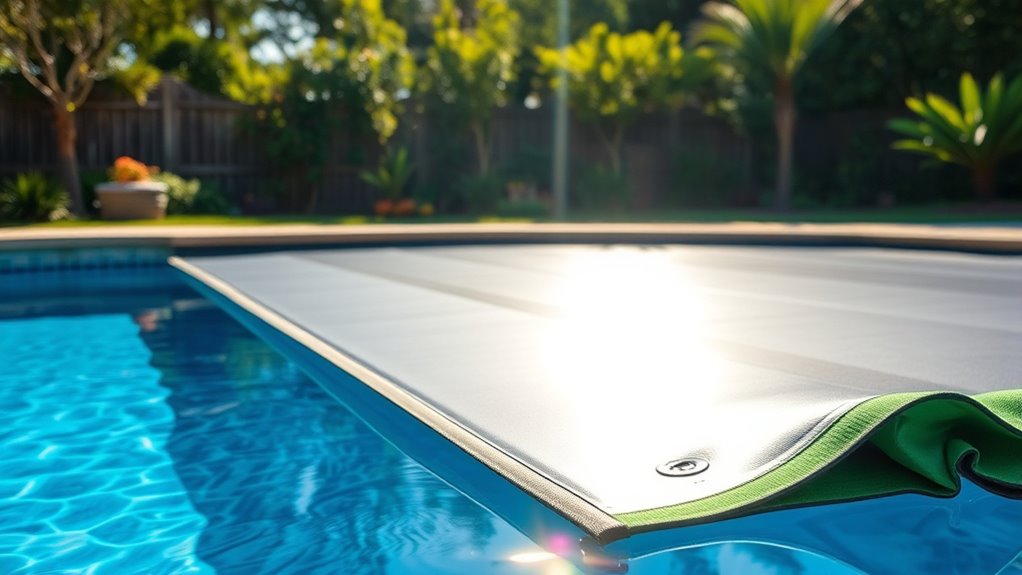
To maximize water conservation, you should use a pool blanket or solar cover effectively by ensuring it fits your pool snugly and is properly maintained. Make sure the cover completely covers the pool surface without gaps, as uncovered areas lead to evaporation. Regularly clean the cover to remove dirt, debris, and algae, which can reduce its insulating properties. When not swimming, keep the cover on to retain heat and prevent water loss. Use a roller or reel for easy removal and storage when you want to swim, ensuring the cover stays in good condition. Check for tears or wear and replace the cover when necessary to maintain its efficiency. Proper use of a pool blanket substantially cuts evaporation and saves water, keeping your pool ready for use and reducing your environmental impact. Additionally, understanding the insulating properties of pool covers can help you select the most effective type for your needs.
Install Wind Barriers Around Your Pool
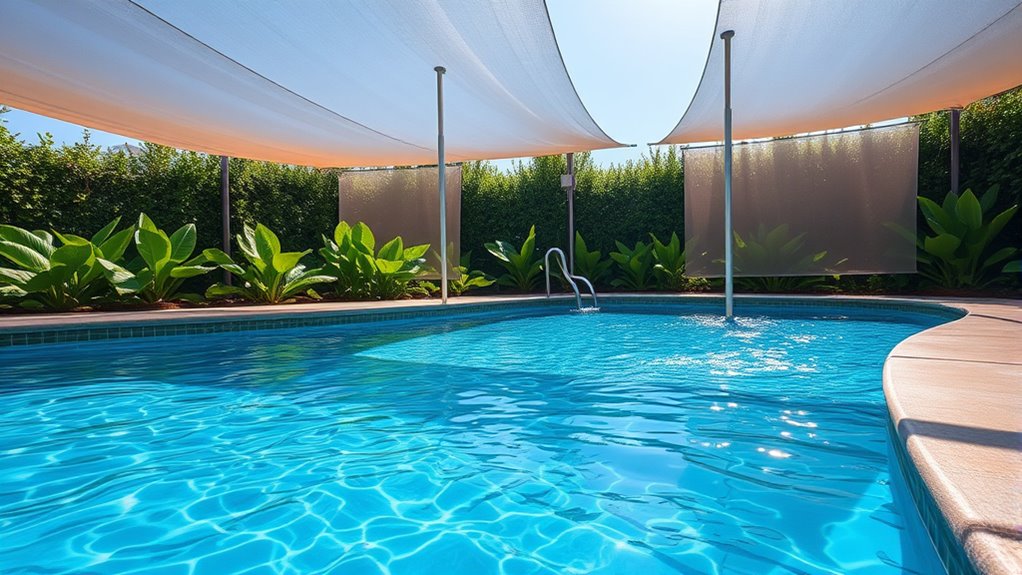
Installing wind barriers around your pool helps reduce airflow losses, keeping your water warmer longer. They also improve wind resistance, preventing strong gusts from disturbing your pool’s surface. With these barriers, you’ll save water and enjoy a more comfortable swimming environment. Incorporating home decoration ideas that complement your pool area can enhance the overall aesthetic and create a more inviting outdoor space.
Reduce Airflow Losses
When wind blows across your pool area, it can greatly increase evaporation and make your pool lose heat more quickly. To reduce airflow losses, consider installing wind barriers like fences, shrubs, or privacy screens around your pool. These barriers slow down the wind, decreasing the rate of water evaporation and heat loss. Position them strategically to block prevailing winds without obstructing sunlight or airflow that helps keep the area dry. Using solid barriers or dense plantings works best, as they create a physical shield against gusts. Regularly maintaining and adjusting these barriers ensures they continue to effectively reduce airflow. Additionally, understanding anime movies can provide relaxing entertainment when you’re looking to unwind after pool maintenance. By minimizing wind exposure, you’ll retain more water and heat, making your pool more energy-efficient and saving you money on water and heating costs.
Enhance Wind Resistance
Enhancing wind resistance around your pool begins with strategic installation of wind barriers. You can use fences, hedges, or wind screens to block gusts that accelerate evaporation. Proper placement is key: position barriers where they shield the most open water without obstructing sunlight or airflow needed elsewhere. Consider the barrier’s height and material; taller, dense screens provide better protection. To visualize, here’s a quick guide:
| Barrier Type | Placement Tips | Benefits |
|---|---|---|
| Solid Fence | Surround perimeter | Blocks wind completely |
| Shrubs/Hedges | Along prevailing wind path | Reduces wind speed gradually |
| Mesh Screens | Partially enclosing area | Balances wind reduction and light |
Using these strategies, you’ll minimize water loss, keeping your pool full and ready for swimming. Additionally, understanding evaporation can help you choose the most effective barriers to conserve water efficiently.
Adjust Water Levels to Prevent Excess Evaporation
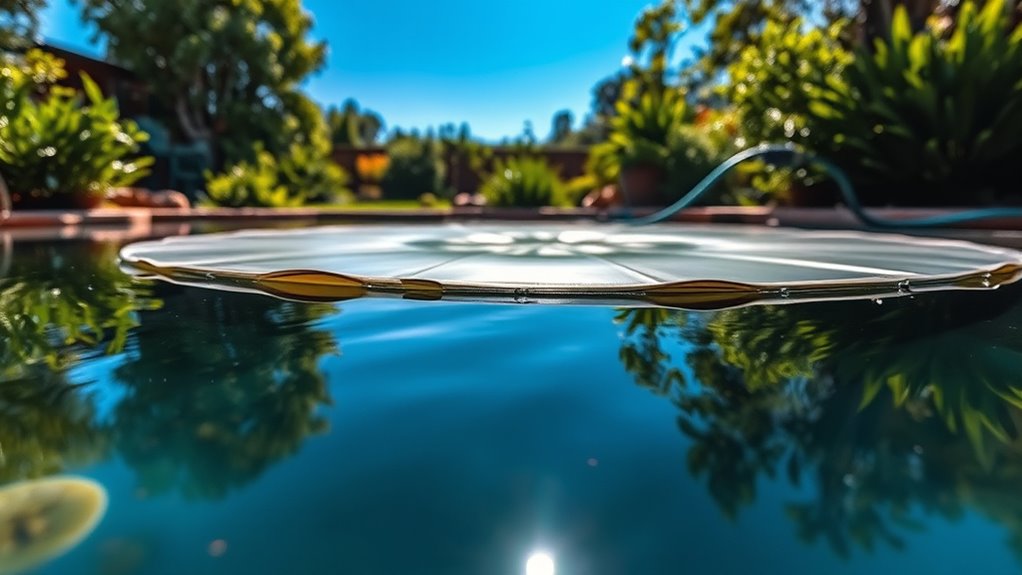
To prevent water from evaporating unnecessarily, you should regularly monitor your pool’s water level and make adjustments as needed. Using floating covers can also help reduce water loss during the day. Additionally, changing the water volume seasonally guarantees you’re not losing more water than necessary when temperatures fluctuate.
Monitor Water Height Regularly
Have you checked your pool’s water level lately? Regularly monitoring it helps you catch evaporation early and adjust promptly. Keep the water at the recommended level—usually halfway up the skimmer opening—to prevent unnecessary loss. Use a simple stick or a water level indicator for quick checks. Maintaining proper water quality also ensures your pool remains clean and safe for swimming.
Use Floating Covers
Using floating covers is an effective way to keep water levels steady and reduce evaporation. These covers sit directly on the pool’s surface, creating a barrier that minimizes water loss caused by evaporation. They are easy to install and remove, making them a practical solution for daily use. When you cover your pool, you’re also helping to maintain consistent water temperature and prevent debris from entering. Choose a cover that fits your pool’s size and shape for maximum efficiency. Keep in mind that floating covers are especially useful during hot or windy days when evaporation rates spike. By blocking sunlight and air contact, you’ll conserve water and reduce the need for frequent refilling, saving both water and money over time. Additionally, selecting the right self watering plant pots can help you manage moisture levels effectively and minimize water waste in your garden.
Adjust Water Volume Seasonally
Adjusting your pool’s water level according to the season helps prevent unnecessary evaporation. During hot, dry months, keep the water slightly higher to compensate for increased loss. Conversely, in cooler seasons, lower the water level to avoid overfilling. Proper water management reduces evaporation and conserves water. To do this effectively, monitor weather forecasts to anticipate heatwaves or cold snaps. Add water gradually during dry spells to maintain ideal levels. Drain excess water before heavy rainstorms to prevent overflow. Use a water level indicator to keep track of changes easily. Regular inspections and understanding home furnishings can help you choose the best tools or covers to further reduce water loss.
Schedule Pool Use During Cooler, Less Windy Times
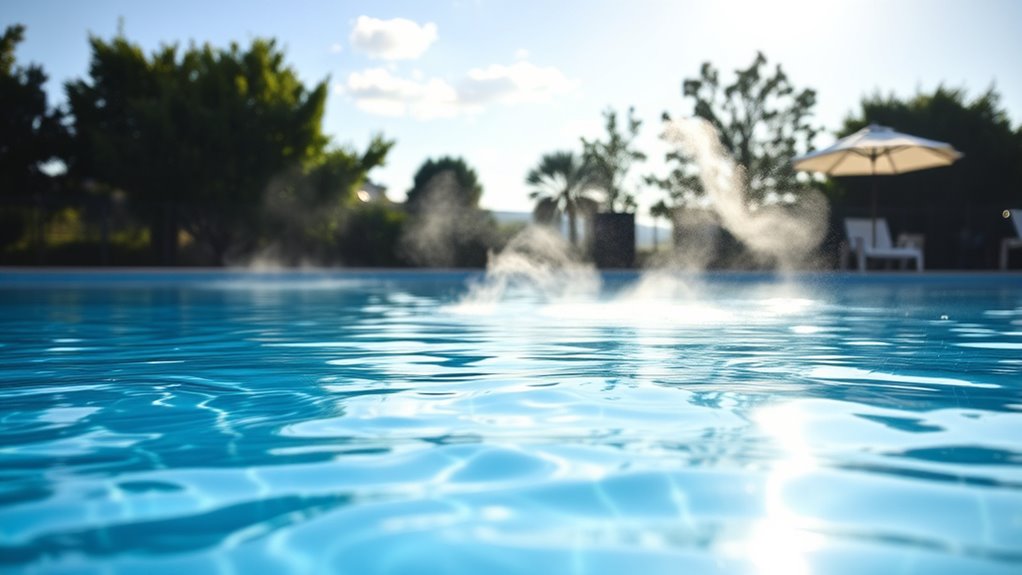
Scheduling pool use during cooler, less windy times helps conserve water by reducing evaporation and evaporation-related losses. You’ll notice less water loss when you swim early mornings or late evenings, especially on calm, cool days. Planning your swimming sessions during these periods minimizes exposure to heat and wind, which accelerate evaporation. To help visualize, here’s a simple guide:
| Time of Day | Weather Conditions | Evaporation Rate |
|---|---|---|
| Early Morning | Cool, calm | Lowest |
| Afternoon | Hot, windy | Highest |
| Evening | Cool, calm | Low |
Choosing these ideal times helps keep more water in your pool, saving you both water and the effort to refill.
Incorporate Water-Absorbing Pool Cover Reels
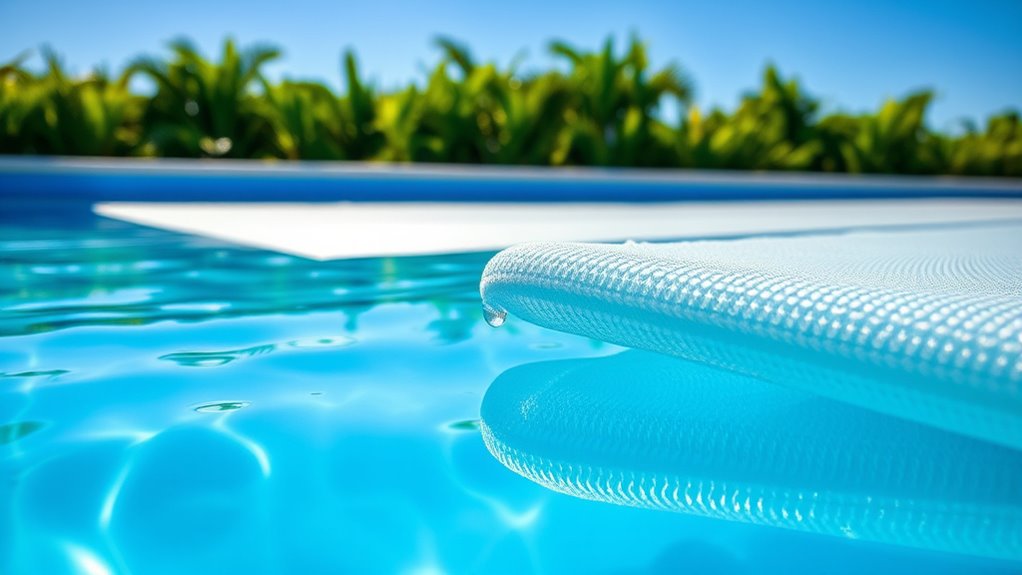
Incorporating water-absorbing pool cover reels can considerably reduce water loss from evaporation. These reels make it easy to quickly cover your pool, especially when not in use, trapping moisture and maintaining water levels. To maximize their effectiveness, consider these tips:
- Choose a reel with a sturdy, weather-resistant design for durability.
- Opt for a cover made from water-absorbing materials to enhance moisture retention.
- Regularly clean and inspect the reel to ensure smooth operation.
- Store the cover properly during off-season to prevent damage and prolong its lifespan.
- Additionally, selecting a Tesla Fire Incidents-resistant cover can provide extra safety during periods of inactivity.
Add Evaporation-Resistant Pool Surface Treatments
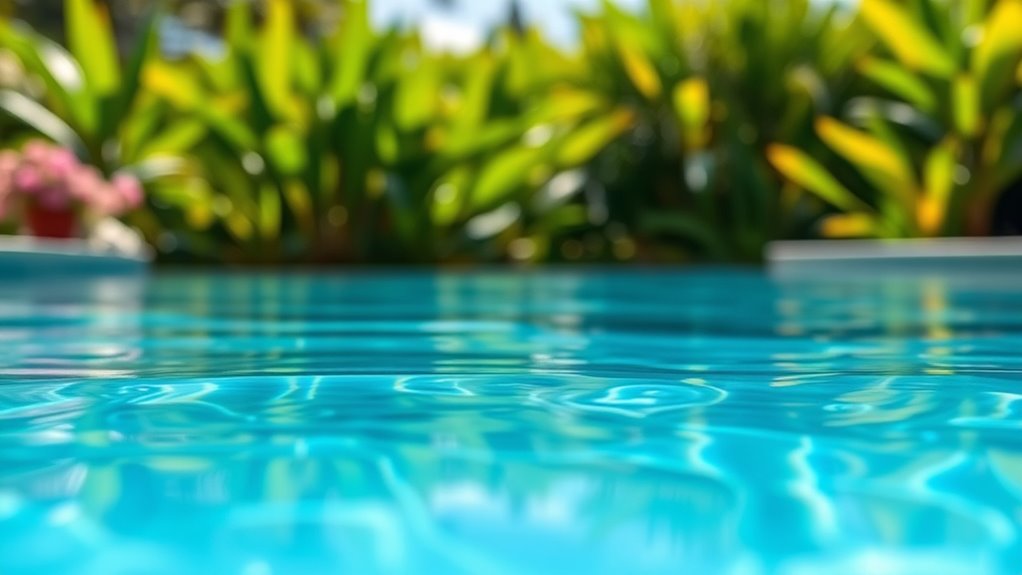
Applying evaporation-resistant pool surface treatments can notably slow down water loss caused by evaporation. These treatments create a thin, protective barrier on your pool’s surface, reducing heat and moisture transfer. By applying a suitable chemical coating or sealant, you can reflect more sunlight and insulate the water, keeping it cooler and minimizing evaporation rates. This approach is especially effective in hot, sunny climates where evaporation speeds up. Make sure to choose a treatment compatible with your pool’s surface material and follow the manufacturer’s instructions for application. Regularly reapplying these treatments ensures continued effectiveness. While they don’t eliminate evaporation entirely, they substantially extend the time your water stays in the pool, helping you save water and maintain your pool’s level with less refilling. Selecting the right treatment can maximize your pool’s protection against water loss.
Maintain Proper Water Chemistry to Reduce Surface Water Loss
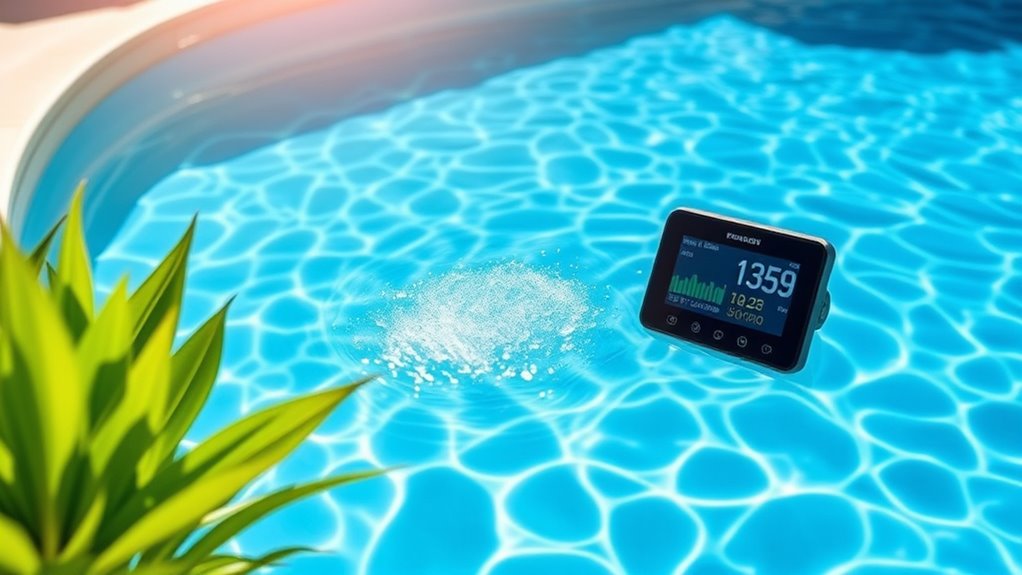
Maintaining proper water chemistry is key to minimizing surface water loss in your pool. When your water’s balanced, it reduces the rate at which water evaporates. To achieve this, keep an eye on these critical factors:
- Maintain pH levels between 7.2 and 7.6 to prevent rapid evaporation caused by imbalanced acidity or alkalinity.
- Keep chlorine levels stable to prevent algae growth, which can increase water loss through surface disturbances.
- Regularly test and adjust alkalinity to stabilize pH and prevent fluctuations.
- Use a water balancer or conditioner if necessary to keep mineral levels in check, reducing evaporation caused by mineral imbalance.
- Incorporate pimple patches into your skincare routine to effectively treat blemishes and prevent the need for excessive washing or scrubbing that can disturb water chemistry.
Consistently monitoring and adjusting these elements helps keep your pool water stable, reducing unnecessary water loss.
Implement Landscaping Strategies to Shield From Wind
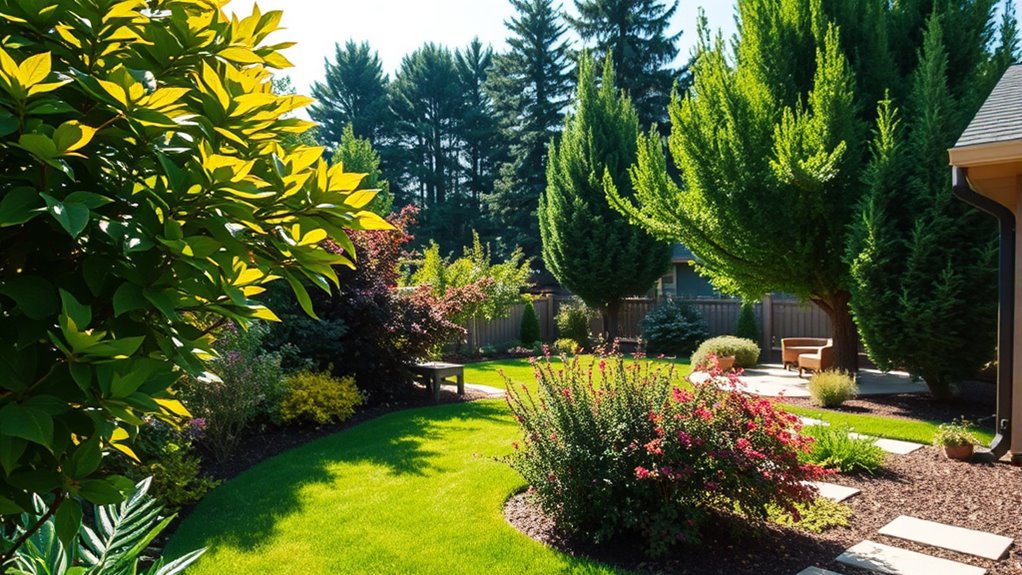
Wind can substantially increase water evaporation from your pool, but you can reduce this loss by strategically using landscaping. Planting shrubs, trees, or installing windbreak fences around your pool creates a barrier that slows wind speed, directly decreasing evaporation rates. Tall, dense plants like evergreens or deciduous trees with broad leaves are especially effective. Position these natural barriers on the prevailing wind side to maximize protection. Additionally, installing a privacy fence or lattice can serve as a windbreak while enhancing your yard’s aesthetics. Proper landscaping not only conserves water but also adds privacy and beauty to your outdoor space. Regularly trimming and maintaining your plants ensures they function effectively as wind shields. Implementing these strategies helps keep your pool water levels stable and reduces water waste.
Frequently Asked Questions
Can Natural Plant Barriers Reduce Pool Evaporation Effectively?
Yes, natural plant barriers can effectively reduce pool evaporation. When you plant shrubs or tall grasses around your pool, they create a microclimate that shields the water from wind and direct sunlight. This slows down the rate of evaporation, helping you conserve water. Plus, they add aesthetic value and provide a natural zone of privacy. Just guarantee the plants are well-maintained and positioned strategically for maximum protection.
How Does Pool Depth Influence Evaporation Rates?
A stitch in time saves nine, and the same applies to pool depth. You’ll find that shallower pools tend to lose water faster due to increased surface area exposure. Deeper pools limit evaporation because less surface area is exposed to air, and the water stays cooler. So, if you want to minimize evaporation, opt for a deeper pool, especially in hot, dry climates where evaporation is more aggressive.
Are There Eco-Friendly Products That Minimize Water Loss?
Yes, eco-friendly products like water-reducing pool covers and biodegradable evaporation retardants can help minimize water loss. You can also opt for solar-powered water features that use less energy and reduce evaporation. Using natural oils or eco-safe algaecides on the water surface creates a thin film that reduces evaporation without harming the environment. These products promote conservation while keeping your pool clean and enjoyable.
What Is the Optimal Timing for Filling a Pool to Reduce Evaporation?
A stitch in time saves nine, so timing is everything. To minimize evaporation, fill your pool early in the morning or late in the evening when temperatures are cooler and wind is calmer. Avoid filling during midday heat or windy days, as this increases water loss. By choosing these times, you help conserve water and keep your pool full longer, making your efforts both eco-friendly and cost-effective.
Can Adding Certain Chemicals Help Retain Water in the Pool?
Adding chemicals like pool sealants or water stabilizers can help retain water by forming a thin, protective layer on the surface, reducing evaporation. These products create a barrier that minimizes water loss due to heat and wind. Make sure to follow the manufacturer’s instructions for proper application and dosage. Regularly testing and maintaining the right chemical balance also keeps your pool water healthy and reduces unnecessary water replacement.
Conclusion
By taking these evaporation hacks to heart, you’ll turn your pool into a fortress against water loss. Think of your efforts as a shield, guarding every precious drop from the relentless sun and wind. With a little planning and the right tools, you’ll keep your pool full and inviting, like a hidden oasis in your backyard. Immerse yourself confidently, knowing you’re mastering the art of water conservation—making every splash count.
